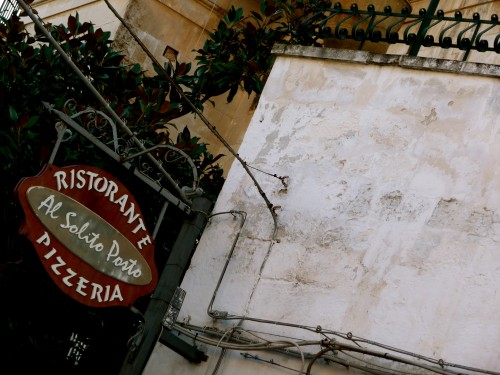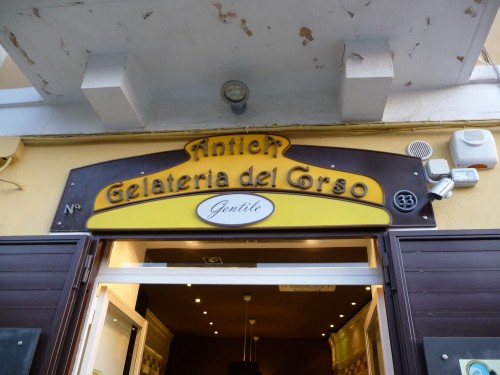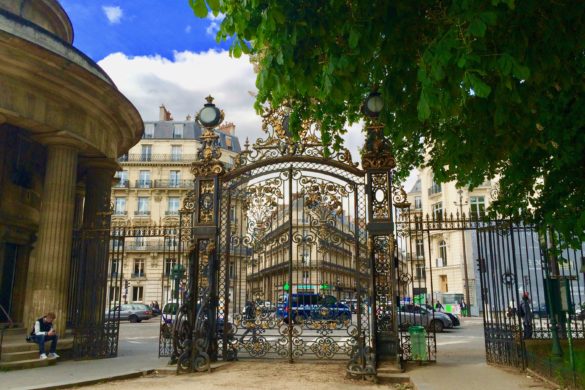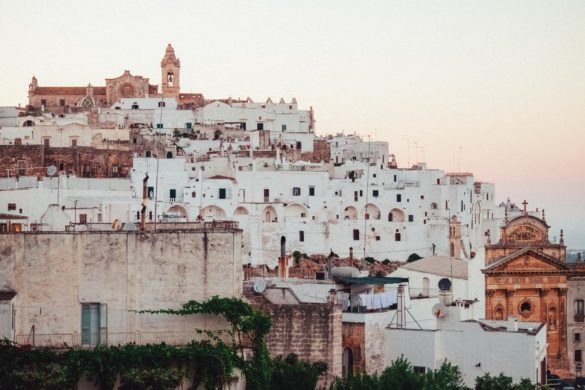
a pizzeria sign in Italy
You may remember I posted Italian language terms for food shopping in Italy, which should be helpful for your travels. But at some point during your trip, you’re obviously going to venture out to eat. Truth be told, if you’re anything like me, it’s one of the reasons you GO to Italy in the first place.
But trying to decipher terms used for dining establishments in Italy can be a bit confusing, so you can use this guide to help you. Maybe, just maybe it will prevent you from attempting to make a reservation at a laundr0mat or seeking out a car repair joint to order a pizza.
Osteria – An osteria is usually a place serving wine and simple food. There is usually a short menu featuring local specialties and sometimes, shared tables. Depending on the osteria you may see a more extensive menu, or they may serve only wine, allowing customers to bring their own food.
Enoteca – A genuine enoteca is a special type of local or regional wine shop. Customers can taste the wines for a small fee and/or purchase bottles. Some could be considered a sort of “wine library,” since they do not sell large quantities of wine, but rather allow travelers to taste and learn more about local wines.
- Tip: A local enoteca is the perfect spot to sample Italian wines with a sommelier, like these in Florence and Venice.
Fiaschetteria – A term more commonly used in Tuscany (specifically in Florence where the term originated), a Fiaschetteria is a wine shop. Fiaschetteria stems from fiasche, the word for the straw bottomed flasks that once transported Tuscan wines from the vineyard. These days, they are small places to get sandwiches, a platter of meats and cheeses, and perhaps even a simple dish to go along with their main fare—wine.
Ristorante – These are restaurants in the truest sense of the word. They are full service, elegant dining establishments with printed menus, hosts/hostesses, fully trained kitchen staff, and even a sommelier. To eat in a ristorante you’ll usually need a reservation, elegant attire and quite possibly a basic knowledge of formal dinnerware. For this style of dining, you’ll likely pay a premium and be expected to order a full three-course meal.
Trattoria – A trattoria offers casual dining—less formal than a ristorante, but with a larger menu than an osteria (though that menu usually isn’t printed—it may be recited or handwritten on a chalkboard). The food is usually less fancy (but still delicious) and you’ll get larger portions. The prices tend to be very reasonable and sometimes they offer takeout.
Tavola Calda – A tavola calda is perhaps the most informal eatery of the ones listed. Literally translated to ‘hot table’, they are typically self-serve, allowing you to choose from a selection of prepared hot dishes. Kind of like cafeteria or buffet, it offers a quick, inexpensive meal.
Paninoteca – These are basically sandwich shops featuring a variety of hot and cold sandwiches, (panini) as well as (sometimes) coffee. You may also come across a Spuntinoteca, which is a place to grab a light snack.
Pizzeria – The first Italian pizzeria, is said to have originated in Naples, and served only one food—pizza. Though many no longer limit their menu to pizza alone, they still specialize in it. A pizzaiolo bakes the pizza in a wood-fired oven to be eaten on the premises or taken out. They usually have informal atmospheres and low prices. Other popular pizzeria fare include fried items like zucchini blossoms and rice balls. Styles of pizza, thickness of crust and toppings will vary by region.

from the sign you can tell gelato is served inside
Gelateria – A shop that sells gelato—Italy’s version of ice cream. Gelato has less butter fat than American ice cream, but more air, so it’s thick and creamy. Don’t let the “less fat” comment fool you into thinking it’s any less delicious—gelato is just as decadent as the ice cream you’re used to (if not more so) and it’s known for a wide variety of rich, fresh flavors. Avoid anything with artificial colorings – pistachio shouldn’t resemble mint chocolate chip, aim for a creamy nut milk color.
Bar/Caffé – At this type of establishment patrons purchase coffee drinks (espresso, cappuccino, macchiato) wine, and liqueur. Kind of a combination of bar and coffee shop wrapped up in one. These bars, however, are not places to consume large quantities of alcohol. They are beautifully decorated and act as centers of social life, usually visited after morning pastries, before or after lunch, to swig back a quick shot of espresso, or for an early evening cocktail. Be aware that many bars have separate pricing depending on where you take your order—sitting at a table (slightly more expensive) or standing at the bar (less).
Birreria – Translating to brasserie or brewery, a birreria is sort of like an alehouse or tavern. These informal joints usually offer food, but they’re known for a wide selection of alcoholic beverages.
Autogrill – The term autogrill is used throughout Italy as a generic word for rest stop. It’s also a brand, referring to the Italian based chain of rest stops by the same name. But don’t let the term lead you to think of a greasy spoon in the States. Instead you will find very high quality coffee drinks and panino. If you see one on the highway, veer off for a visit – you won’t be sorry!
Are you planning a visit to Italy? Click here to see how I can help.
Written by: Kelly Whelan


